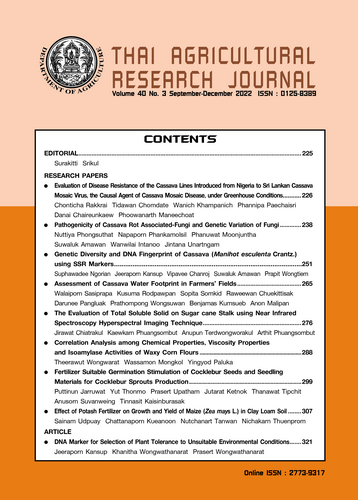Genetic Diversity and DNA Fingerprint of Cassava (Manihot esculenta Crantz.) Using SSR Markers
DOI:
https://doi.org/10.14456/thaidoa-agres.2022.21Keywords:
Manihot esculenta, SSR marker, Genetic diversity, DNA fingerprintAbstract
The genetic diversity of cassava is an important information for conducting research and development to improve cassava variety. This research aimed to assess the genetic diversity and to analyse clusters of 270 cassava varieties from DOA germplasm collection at Rayong Field Crops Research Center, Department of Agriculture using 16 fluorescent-labeled SSR markers. Results showed that 16 SSR markers were able to differentiate well in the cassava genome, generating polymorphic alleles in total of 88 alleles varying from 3 – 9 alleles per locus, with an average of 5.5 alleles per locus. All 88 alleles showed the polymorphic bands accounted for 100%. Sizes of DNA fragments ranged from 100 – 418 base pairs. The Polymorphism Information Content (PIC) value ranged from 0.38 – 0.78, with an average of 0.63. Cluster analysis based on UPGMA and genetic relationships using NTSYSpc version 2.10e showed similarity in coefficient value in range of 0.10 – 1.00, and revealed 3 major distinct groups, consistent with pedigree and geographical locations, with cophenetic correlation (r) of 0.70. Therefore, SSR markers in this study were suitable for identifying the genetic differences of cassava varieties, and the genetic diversity database of cassava is useful for parental selection in cassava breeding programs.
References
สุภาวดี ง้อเหรียญ จีราพร แก่นทรัพย์ บุญเรือนรัตน์ เรืองวิเศษ วิภาวี ชั้นโรจน์ สุวลักษณ์ อะมะวัลย์ และประพิศ วองเทียม. 2562. การศึกษาความหลากหลายทางพันธุกรรมของมันสำปะหลังโดยใช้เครื่องหมายโมเลกุลชนิด SSR. วารสารวิชาการเกษตร. ปีที่ 37(1): 2-13.
Botstein, D., R.L. White., M. Skolnick and R.W. Davis. 1980. Construction of a genetic linkage map in man using restriction fragment length polymorphisms. Am. J. Hum. Genet. 32(3): 314-331.
Dellaporta, S.L., J. Wood and J.B. Hicks. 1983. A plant DNA minipreparation: Version II, Plant Mol. Biol. Rep. 1(4): 19-21.
Elias, M.; O. Panaudà and T. Robertà. 2000. Assessment of genetic variability in a traditional cassava (Manihot esculenta Crantz) farming system, using AFLP markers. The Genetical Society of Great Britain. 85(2000): 219 – 230.
Hokanson, S.C.; A.K. Szewc-McFadden.; W.F. Lamboy and J.R. McFerson. 1998. Microsatellite (SRR) markers reveal genetic identities, genetic diversity and relationships in a Malus x domestica borkh. core subset collection. Theor. Appl. Genet. 97: 671–683.
Jorge, V.; M.A. Fregene.; M.C. Durque.; M.W. Bonierbale.; J. Tohme and V. Verdier. 2000. Genetic mapping of resistance to bacterial blight disease in cassava (Manihot esculenta Crantz). Theor. Appl. Genet. 101(5): 865 – 872.
López, C.; B. Piegu.; R. Cooke.; M. Delseny.; J. Tohme and V. Verdier. 2005. Using cDNA and genomic sequences as tools to develop SNP strategies in cassava (Manihot esculenta Crantz). Theor. Appl. Genet. 110(3): 425 – 431.
Pillai, S.V., S.P. Manjusha and S. Sundaresan. 2004. Molecular diversity in the land races of cassava in India based on RAPD markers. In the Sixth International Scientific meeting of the Cassava Biotechnology Network. CIAT, Cali, Colombia, March 8-14. 45 p.
Rohlf, F.J. 2000. NTSYS-pc: Numerical Taxonomy and Multivariate Analysis System Version 2.1. Exeter Publishing Setauket, New York.
Sirithunya, P.; E. Roumen.; S. Mongkolsomrit.; S. Sriprakhon.; P. Hutamekalin and T. Sreewongchai. 2001. Instruction manual workshop on molecular genetic analysis on diversity of blast pathogen in Thailand. Yothee laboratory Unit Bangkok, Thailand.
Vásquez A. and C. López. 2014. In Silico Genome Comparison and Distribution Analysis of Simple Sequences Repeats in Cassava. Int. J. Genomics. 2014: 471461. 9 p.
Yu, J.Z., D.D. Fang, R.J. Kohel, M. Ulloa, L.L. Hinze, R.G. Percy and D.C. Jones. (2012). Development of a core set of SSR markers for the characterization of Gossypium germplasm. Euphytica. 187(2): 203-213.
Downloads
Published
How to Cite
Issue
Section
License
Copyright (c) 2022 Thai Agricultural Research Journal

This work is licensed under a Creative Commons Attribution-NonCommercial-NoDerivatives 4.0 International License.
Thai Agricultural Research Journal



